The Pandur I is an Austrian 6x6 wheeled armored vehicle designed and manufactured by Steyr-Daimler-Puch (now GD ELS), designed as APC but declined into multiple variants, with reconnaissance, fire support and other specialists. The Pandur I was used by Austria (now superseded by the Pandur II), and produced under licence in Kuwait, Slovenia (Valuk), Belgium or the US for special forces. The first were demonstrated in 1985 so it's why the article is displayed in the cold war section.
The Pandur proceeded of the idea of a modular, light (6x6) wheeled APC to replace costier and slower tracked vehicles after the end of the cold war, albeit Steyr-Daimler-Puch was interested to develop the Piranha II locally for the domestic and export markets. The development and production of the Pandur 6x6 family by Steyr-Daimler-Puch Spezialfahrzeug GmbH (SSF) was indeed strted as a private venture. The small Austrian army at the time already had in service the tracked 4K4FA.
The internal program was called the "personnel transport tank" (MTPz) and was developed in 1979 by Steyr Spezial Vehicles. The first demonstration vehicles were demonstrated to the Austrian Army in 1985. But it met export orders in the following years after an initial refusal. Its modified variant was introduced in the Austrian Armed Forces in 1996 at last after years of army tests.
The 1980-90s years were a considerable gap. But the vehicle had its official tests in 1985, and production started in 1986 for export. In 1994, 68 Pandurs APCs were at last officially ordered. The first were completed in December 1995. They were armed with a 12.7mm Browning M2 machine gun as standard. It seems prototypes were tested at the factory already in 1983-84, with army tests and development towards more modularity and export starting in 1985.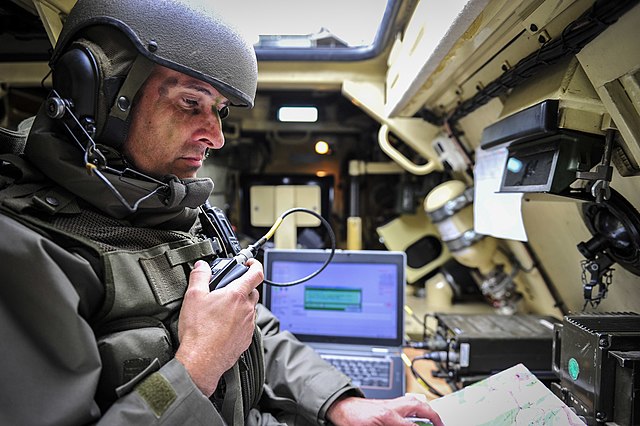
Interior of a Pandur I
The MTPz/UN-A1 “Pandur” is a compact vehicle, at 5,790mm in lenght, 2,500mm in width and 2,760 mm in heightn at the top of the rotating ring mount. Overall weight was comparable, but heavier, than the 8x8 stryker, at 13.5 t combat weight. The initial version had a flat roof (later dubbed "Pandur IB") and so the final variant presented to the Austrian Army was intended for United Nations duties, and as asked had a raised rear hull roof ("Pandur IA") to increase internal head space for the eight troops. Both hulls shared the same externally 12.7 mm (0.5 in) Browning M2 heavy machine gun over the commander's cupola, protected by shields on all sides, as combat shown in Afghanistan and Iraq.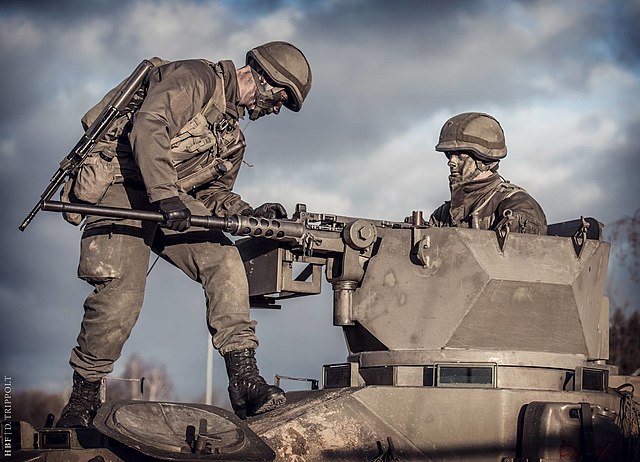
Pandur change HMG
The Pandur is close in design to the Mowag Piranha II, from the 6x6 configuration to the shape of the hull and dimensions. The hull shape is prismatic, with an edgy nose and all-welded steel armour. The base model was designed without turret but firing ports on the hull sides, and rear doors, plus roof hatches. For the crew it carried up to 9 men: A driver, followed by the commander on the same (right) side, a smaller cupola hatch on the left side followed by 6-7 fully equipped infantry seated in the rear compartment for the APC variant. Aover their heards were placed four hatches of various sizes, three large and one smaller behind the left cupola hatch.
The hull is 5.69 m in lenght, 2.5 m wide and 1.82 m in height, albeit this changes as it came out in two main body variants: The basic hull, called "A" had an extended centre roof as asked by the Austrian staff, and was declined mostly for UN use, as an Armoured Personnel Carrier, Ambulance, Anti-tank vehicle, Repair and recovery vehicle and Command post vehicle. This is the variants also chosen by Belgium and Slovenia as the Valuk.
The "B" hull however is the "flat one", lighter. This mades also an amphibious vehicle with greater buoyancy, equipped by two water jets and declined into a Mortar carrier and Reconnaissance Fire Support Vehicle. It was chosen by Kuwait, built in the US and likely also tested by the US (USASOC) for special forces.
For protection, the Pandur I is limited to light armour overall, counting on sloped faces also. It is protected against 12.7mm rounds on its 30° frontal arc (so likely 10 mm sloped) and against 7.62mm rounds and shrapnels everywhere else (likely 6 mm). There is an internal spall liner, and it has an automatic fire extinguishing system for the engine compartment and heater.
NBC protection is only offered as an option, with a detection/protection system. A fire suppression system for the crew compartment is also optional, as the air conditioning system. Another option is the recovery winch in the nose, connected to the transmission for self-recovery only. There is also a land navigation system.
Passive night vision equipment included thermal sights for the commander and gunner, but only in the two-man turret configuration. The air conditionin system is installed on the left rear side of the hull while the recovery winch could be installed on the right side of the hull. The hull has no fixation bolts for extra armour. Smoke dischargers are not present either on the basic model.
It is capable of pushing the vehicle up to 100 km/h on road (tests). Full combat loaded on flat it is around 80 kph in common use. Its Climbing capability is up to 70%, Range is about 700 km. All axles are independent, but independent suspension with power steering are only on the first and second axles (upper longitudinal control arm, lower transverse control arm, coil springs). The rearmost axle only has a trailing arm and torsion bar.
The Pandur 1 has a central tyre-pressure regulation system to adjust to ground types at any time and on the move. The tyres has an emergency run-flat system and thus could still run over 50 km even with all tyres bullet-holed. Steyr-Daimler-Puch developed, as a private venture, the Automatic Drivetrain Management (ADM) system for off-road conditions. It is now proposed as an option. The Pandur B type was made Amphibious, thanks to a serie of option: Positive buyoancy, water-to-water cooling, closed air intake, electric bilge pumps, water jet aft (11 km/h swimming).
The most impressive was the fire support version (ARFSV) which was a Cockerill LCTS model tailored to carry several types of low or medium 90 mm gun intended for armored reconnaissance units support. The mortar carrier features a 81 mm mortar firing through hull roof hatches. There was also an anti-tank guided missile turret as well as various prototypes showcased in arms exhibitions, with air defence guns, SPAAML missile turret. Just like the Piranha II, the Pandur could be remarkably fast to convert to any use without major redesign. The main production variants as the following:
Slovenian Valuk, winter exercizes
The Austrian army was the first customer of the vehicle, ten years after the first demonstrations. It seems it was only to fulfill its ongoing obligations to the United Nations.
After the 1994 Austrian order (always reassuring foreign customers), by October 1996, the Kuwait National Guard placed an order in turn, but with AV Technology International for 70 Pandur to be built there in six variants. The first production vehicles were released by November 1997.
The same year, the Belgian government acquired the licence for local production and by November 1998, the Belgian Army took delivery of 54 Pandur APCs. They were intended for the Para Commando Brigade. Variants included 41 APCs (Armoured Personnel Carrier), five command post (CP) vehicles, four maintenance/recovery vehicles (ARV) and four ambulance vehicles (ambutanks).
Slovenia selected the Pandur after an international competition as well for its wheeled APC program. The Pandur was manufactured under licence in Slovenia by STO RAVNE and as "Valuk". The first were tested by the Slovenian Army in 1999. The Valuk is generally similar to the Austrian vehicles but with a ramp at the rear instead of double doors.
Last but not least, by the end of 1999, the US Army itself (which tested the vehicle through AV Technology International) was interested and ordered 50 Pandur, with 12 delivered for evaluation. They are used by the USASOC Special Forces/Special Operations Forces units).
It seems also a few were also adopted by the Royal Solomons Islands police and Equatorial Guinea army.
In the 2000s the Austrian army started to upgrade the Pandur, adapting the 12.7mm Browning remote weapon station. By March 2015 Swiss RUAG announced it was developing an upgrade package for Pandur 1 marketed to the Austrians, and Belgian armies. The new vehicle is fitted with an "urban combat" kit, and is protected against mine, IED and RPGs. So far no order was made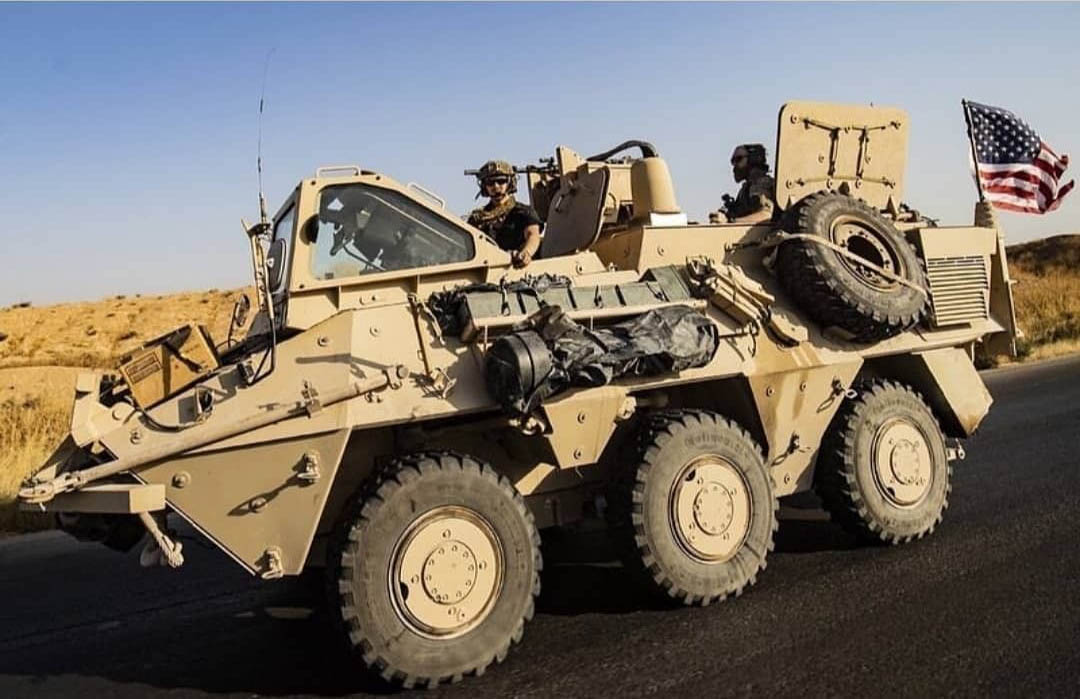
Pandur USASOC in Afghanistan 2000s
After training, Austrian units fielded the Pandur I in 1996 deployed them after training in 1999, deployed in Kosovo AUTCON/KFOR and with AUTCON/ORF. They also saw action in Afghanistan with AUTCON/ISAF, Bosnia-Herzegovina with AUTCON/ALTHEA in peacekeeping operations. Pandurs left Bosnia in 2004. In 2003 three medical Pandurs SanPzRd were purchased. Seven personnel carriers were purchased from Belgium for evaluation, and a licence acquired. These vehicles were thus used for spare parts only. The Federal Austrian Army modified the Pandur 1 into the Pandur 1A1 after numerous abroad combat experience reports.
By the end of 2018, the UN-A1 stationed in Austria constituted the single "Jägerbataillon 17" (Straß) of the 3rd Jägerbrigade. 34 new Pandur EVOs were delivered to Jägerbataillon 17, and so the total of 68 remaining Pandur were split between Jägerbataillons 19 (based in Güssing) and 33 (based in Zwölfaxing). In 2011 JgB 17 joined EU Battlegroup for a year. The prototype Pandur of 1979, decommissioned, was used by the Austrian Federal Police at the Crane Operations Department at Vienna-Schwechat Airport.
Due to the refugee crisis in Europe from 2015, a Pandur deployed to patrol the border crossing in Hügelsheim. It was equipped with fold-out scissor guards and intended to secure the motorway in event of a barricade being made by the refugee.
The Pandur II was a completely new vehicle from GDLS (which absorbed Steyr), sharing little with the Pandur 1 and 1A1 but a few components. It was declined both in "short" and "long" hull, but this time not just for an extra wheelbase, but in 6x6 or 8x8 configuration for greater flexibility. The two share more than 90% components.
The Pandur II is granted the far larger Cummins ISLe HPCR series diesel engine rated for 298 kW (400+ hp) for the 6x6 version and 335 kW (hp) for the 8x8, coupled in both cases with a ZF 6HP 602C fully automatic 6-gear transmission and 2 stage transfer gear shiftable on the move for 12 gears totals. Top speed is 105 km/h.
The V-shaped hull floor fully protects the power train and steering linkages and its turning diameter uses a steering brake for an extra all curve-inner wheels when fully turned. The 8x8 is thus capable of very tight turns. Modularity is even greater than the previous vehicle due to the choice of configurations. It is intended to replace all variants in the Austrian inventory. The Pandur II comes with a 30 mm Mk44 Bushmaster II in IFV variant, 105 mm Cockerill high-pressure gun in heavy infantry support variant, while the base vehicle has a RWS heavy machine gun 0.50 in (12.7 mm) M2 coupled with a 7.62 mm FN MAG machine gun, or the later alone for some sepcialized variants. An anti-tank variant has been developed, carrying either the Spike LR or TOW anti-tank guided missile.
So far the Pandur II had been produced for Austria (34 ordered 2016) the Czech army (127 total in all variants) from 2013, Indonesia (22 ordered in 2019) and it is built under licence in Portugal, 188 units in 9 variants. Negociations with the Philippines are ongoing.
militaryfactory.com
army-technology.com
tvd.im/land-systems
armyrecognition.com
www.steyr-ssf.com
militarytoday.com
en.wikipedia.org
bmlv.gv.at
www.24ur.com
commons.wikimedia.org
The Austrian Piranha
The Pandur I (retroactively called as such due to the Pandur II being presented in 2002 as brand new replacement) is the first home-grown wheeled APC of Austria. It is was cold war vehicle, as designed over a long time by Steyr-Daimler-Puch Spezialfahrzeuge (SSF), from 1979 onwards but only in service by 1996. It was designed as very modular like the Piranha II 6+6 and shares some similarities with the Spanish Pegaso, which is not random as both countries collaborated on several programs, included the Uhlan (Spanish Pizarro).The Pandur proceeded of the idea of a modular, light (6x6) wheeled APC to replace costier and slower tracked vehicles after the end of the cold war, albeit Steyr-Daimler-Puch was interested to develop the Piranha II locally for the domestic and export markets. The development and production of the Pandur 6x6 family by Steyr-Daimler-Puch Spezialfahrzeug GmbH (SSF) was indeed strted as a private venture. The small Austrian army at the time already had in service the tracked 4K4FA.
The internal program was called the "personnel transport tank" (MTPz) and was developed in 1979 by Steyr Spezial Vehicles. The first demonstration vehicles were demonstrated to the Austrian Army in 1985. But it met export orders in the following years after an initial refusal. Its modified variant was introduced in the Austrian Armed Forces in 1996 at last after years of army tests.
The 1980-90s years were a considerable gap. But the vehicle had its official tests in 1985, and production started in 1986 for export. In 1994, 68 Pandurs APCs were at last officially ordered. The first were completed in December 1995. They were armed with a 12.7mm Browning M2 machine gun as standard. It seems prototypes were tested at the factory already in 1983-84, with army tests and development towards more modularity and export starting in 1985.
Design of the Pandur

Interior of a Pandur I
The MTPz/UN-A1 “Pandur” is a compact vehicle, at 5,790mm in lenght, 2,500mm in width and 2,760 mm in heightn at the top of the rotating ring mount. Overall weight was comparable, but heavier, than the 8x8 stryker, at 13.5 t combat weight. The initial version had a flat roof (later dubbed "Pandur IB") and so the final variant presented to the Austrian Army was intended for United Nations duties, and as asked had a raised rear hull roof ("Pandur IA") to increase internal head space for the eight troops. Both hulls shared the same externally 12.7 mm (0.5 in) Browning M2 heavy machine gun over the commander's cupola, protected by shields on all sides, as combat shown in Afghanistan and Iraq.
Hull and protection

Pandur change HMG
The Pandur is close in design to the Mowag Piranha II, from the 6x6 configuration to the shape of the hull and dimensions. The hull shape is prismatic, with an edgy nose and all-welded steel armour. The base model was designed without turret but firing ports on the hull sides, and rear doors, plus roof hatches. For the crew it carried up to 9 men: A driver, followed by the commander on the same (right) side, a smaller cupola hatch on the left side followed by 6-7 fully equipped infantry seated in the rear compartment for the APC variant. Aover their heards were placed four hatches of various sizes, three large and one smaller behind the left cupola hatch.
The hull is 5.69 m in lenght, 2.5 m wide and 1.82 m in height, albeit this changes as it came out in two main body variants: The basic hull, called "A" had an extended centre roof as asked by the Austrian staff, and was declined mostly for UN use, as an Armoured Personnel Carrier, Ambulance, Anti-tank vehicle, Repair and recovery vehicle and Command post vehicle. This is the variants also chosen by Belgium and Slovenia as the Valuk.
The "B" hull however is the "flat one", lighter. This mades also an amphibious vehicle with greater buoyancy, equipped by two water jets and declined into a Mortar carrier and Reconnaissance Fire Support Vehicle. It was chosen by Kuwait, built in the US and likely also tested by the US (USASOC) for special forces.
For protection, the Pandur I is limited to light armour overall, counting on sloped faces also. It is protected against 12.7mm rounds on its 30° frontal arc (so likely 10 mm sloped) and against 7.62mm rounds and shrapnels everywhere else (likely 6 mm). There is an internal spall liner, and it has an automatic fire extinguishing system for the engine compartment and heater.
NBC protection is only offered as an option, with a detection/protection system. A fire suppression system for the crew compartment is also optional, as the air conditioning system. Another option is the recovery winch in the nose, connected to the transmission for self-recovery only. There is also a land navigation system.
Passive night vision equipment included thermal sights for the commander and gunner, but only in the two-man turret configuration. The air conditionin system is installed on the left rear side of the hull while the recovery winch could be installed on the right side of the hull. The hull has no fixation bolts for extra armour. Smoke dischargers are not present either on the basic model.
Mobility
Installed on the right side in the front compartment, the Steyr 6-cylinder WD 612.95 (WD 612.35) 6-cylinder turbocharged water-cooled diesel, fitted with air-intake cooling. It is rated for 191 kW (260 hp), providing 960 Nm torque, or 260 hp (285 hp at 2,500 rpm) at 2,400 rpm. It is linked to an Allison Transmission MT-653 DR, 5-speed, with torque converter, lock up clutch. The Pandur could almost turn on itself and do a full 360° in eight seconds.It is capable of pushing the vehicle up to 100 km/h on road (tests). Full combat loaded on flat it is around 80 kph in common use. Its Climbing capability is up to 70%, Range is about 700 km. All axles are independent, but independent suspension with power steering are only on the first and second axles (upper longitudinal control arm, lower transverse control arm, coil springs). The rearmost axle only has a trailing arm and torsion bar.
The Pandur 1 has a central tyre-pressure regulation system to adjust to ground types at any time and on the move. The tyres has an emergency run-flat system and thus could still run over 50 km even with all tyres bullet-holed. Steyr-Daimler-Puch developed, as a private venture, the Automatic Drivetrain Management (ADM) system for off-road conditions. It is now proposed as an option. The Pandur B type was made Amphibious, thanks to a serie of option: Positive buyoancy, water-to-water cooling, closed air intake, electric bilge pumps, water jet aft (11 km/h swimming).
Armament & Variants
The basic APC is provided a Browning 12.7 mm HMG-2 in the one-man cupola turret. It was before RWS systems. Depending on variants, including by country, the armament could diverge. The initial 68 order was followed by many more and as most countries chosed the Type A variant, Kuwait and the US settled on the Pandur IB. The former was to adapt the Steyr two-man turret IFV turret similar to the one used by the LAV-25, or the Cockerill 90 mm LCTS gun turret. The later comprised in addition a third MICV 127 one-man turret with a single 12.7 and coaxial 7.62 mm machine gun. The "stryker turret" was a two man model armed, not with the 25 mm Bushmaster but the Mauser 30 mm cannon.The most impressive was the fire support version (ARFSV) which was a Cockerill LCTS model tailored to carry several types of low or medium 90 mm gun intended for armored reconnaissance units support. The mortar carrier features a 81 mm mortar firing through hull roof hatches. There was also an anti-tank guided missile turret as well as various prototypes showcased in arms exhibitions, with air defence guns, SPAAML missile turret. Just like the Piranha II, the Pandur could be remarkably fast to convert to any use without major redesign. The main production variants as the following:
Ambulance (A hull):
Higher raised rear compartment, rear wheelbase increased from 1.53 to 1.83 m for greater volume. Three stretcher/seating configurations, four stretcher, or two stretcher+three sitting/six seated and full medical equipment.Reconnaissance fire support (Pandur RFS, A hull):
Cockerill or Steyr two-man turret depending on customer's needs (30 mm), or 90 mm LCTS turret system and Mk 8 gun system for example. Like those used by the Kuwaiti National Guard, on the "B" hull.Pandur ATGM:
Antitank guided missile carrier with the ATGMC/HOT and Euromissile UTM 800 launcher.Pandur reconnaissance:
Two-man Steyr-Daimler-Puch SP3/300 turret, 30 mm Mauser MK 30 cannon.Pandur Mortar Carrier:
A hull, open 81 mm turntable-mounted mortar (AMC81)/120 mm mortar in rear compartment.Pandur AA:
Anti-aircraft variant with power-operated turret, twin 20 mm.Pandur ARV:
Recovery Vehicle, crane on the top of the hull, winch and other equipments.Operators

Slovenian Valuk, winter exercizes
The Austrian army was the first customer of the vehicle, ten years after the first demonstrations. It seems it was only to fulfill its ongoing obligations to the United Nations.
After the 1994 Austrian order (always reassuring foreign customers), by October 1996, the Kuwait National Guard placed an order in turn, but with AV Technology International for 70 Pandur to be built there in six variants. The first production vehicles were released by November 1997.
The same year, the Belgian government acquired the licence for local production and by November 1998, the Belgian Army took delivery of 54 Pandur APCs. They were intended for the Para Commando Brigade. Variants included 41 APCs (Armoured Personnel Carrier), five command post (CP) vehicles, four maintenance/recovery vehicles (ARV) and four ambulance vehicles (ambutanks).
Slovenia selected the Pandur after an international competition as well for its wheeled APC program. The Pandur was manufactured under licence in Slovenia by STO RAVNE and as "Valuk". The first were tested by the Slovenian Army in 1999. The Valuk is generally similar to the Austrian vehicles but with a ramp at the rear instead of double doors.
Last but not least, by the end of 1999, the US Army itself (which tested the vehicle through AV Technology International) was interested and ordered 50 Pandur, with 12 delivered for evaluation. They are used by the USASOC Special Forces/Special Operations Forces units).
It seems also a few were also adopted by the Royal Solomons Islands police and Equatorial Guinea army.
In the 2000s the Austrian army started to upgrade the Pandur, adapting the 12.7mm Browning remote weapon station. By March 2015 Swiss RUAG announced it was developing an upgrade package for Pandur 1 marketed to the Austrians, and Belgian armies. The new vehicle is fitted with an "urban combat" kit, and is protected against mine, IED and RPGs. So far no order was made
The Pandur in action

Pandur USASOC in Afghanistan 2000s
After training, Austrian units fielded the Pandur I in 1996 deployed them after training in 1999, deployed in Kosovo AUTCON/KFOR and with AUTCON/ORF. They also saw action in Afghanistan with AUTCON/ISAF, Bosnia-Herzegovina with AUTCON/ALTHEA in peacekeeping operations. Pandurs left Bosnia in 2004. In 2003 three medical Pandurs SanPzRd were purchased. Seven personnel carriers were purchased from Belgium for evaluation, and a licence acquired. These vehicles were thus used for spare parts only. The Federal Austrian Army modified the Pandur 1 into the Pandur 1A1 after numerous abroad combat experience reports.
By the end of 2018, the UN-A1 stationed in Austria constituted the single "Jägerbataillon 17" (Straß) of the 3rd Jägerbrigade. 34 new Pandur EVOs were delivered to Jägerbataillon 17, and so the total of 68 remaining Pandur were split between Jägerbataillons 19 (based in Güssing) and 33 (based in Zwölfaxing). In 2011 JgB 17 joined EU Battlegroup for a year. The prototype Pandur of 1979, decommissioned, was used by the Austrian Federal Police at the Crane Operations Department at Vienna-Schwechat Airport.
Due to the refugee crisis in Europe from 2015, a Pandur deployed to patrol the border crossing in Hügelsheim. It was equipped with fold-out scissor guards and intended to secure the motorway in event of a barricade being made by the refugee.
Towards the Pandur II

The Pandur II was a completely new vehicle from GDLS (which absorbed Steyr), sharing little with the Pandur 1 and 1A1 but a few components. It was declined both in "short" and "long" hull, but this time not just for an extra wheelbase, but in 6x6 or 8x8 configuration for greater flexibility. The two share more than 90% components.
The Pandur II is granted the far larger Cummins ISLe HPCR series diesel engine rated for 298 kW (400+ hp) for the 6x6 version and 335 kW (hp) for the 8x8, coupled in both cases with a ZF 6HP 602C fully automatic 6-gear transmission and 2 stage transfer gear shiftable on the move for 12 gears totals. Top speed is 105 km/h.
The V-shaped hull floor fully protects the power train and steering linkages and its turning diameter uses a steering brake for an extra all curve-inner wheels when fully turned. The 8x8 is thus capable of very tight turns. Modularity is even greater than the previous vehicle due to the choice of configurations. It is intended to replace all variants in the Austrian inventory. The Pandur II comes with a 30 mm Mk44 Bushmaster II in IFV variant, 105 mm Cockerill high-pressure gun in heavy infantry support variant, while the base vehicle has a RWS heavy machine gun 0.50 in (12.7 mm) M2 coupled with a 7.62 mm FN MAG machine gun, or the later alone for some sepcialized variants. An anti-tank variant has been developed, carrying either the Spike LR or TOW anti-tank guided missile.
So far the Pandur II had been produced for Austria (34 ordered 2016) the Czech army (127 total in all variants) from 2013, Indonesia (22 ordered in 2019) and it is built under licence in Portugal, 188 units in 9 variants. Negociations with the Philippines are ongoing.
Links
tanknutdave.commilitaryfactory.com
army-technology.com
tvd.im/land-systems
armyrecognition.com
www.steyr-ssf.com
militarytoday.com
en.wikipedia.org
bmlv.gv.at
www.24ur.com
commons.wikimedia.org
Pandur I APC specifications | |
| Dimensions | 5.7 x 2.5 x 1.82m (18 ft 8 in x 8 ft 2 in x 6.0 ft) |
| Total weight, battle ready | 13.5 tonnes |
| Propulsion | Steyr 6-cyl. TD 194 kW (260 bhp) 2,400 rpm |
| Suspension | Torsion bars |
| Speed (road) | 100 km/h (62 mph) |
| Range | 700 km (430 mi) |
| Armament | 12.7mm Cal. 50 HMG post (APC) |
| Armor | Prot. against 12.7mm ft arc, 7.62 mm everywhere. |
| Total production | c400 |
| Crew | 2+8 (driver, gunner, 8 infantrymen) |
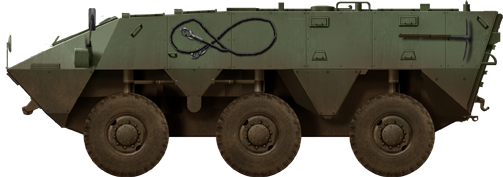
Austrian Pandur I Type A
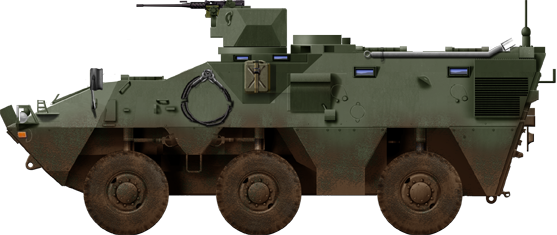
Pandur I, Type B
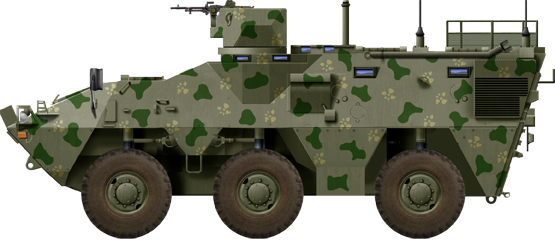
Kuwaiti nat. Guard Pandur I CP
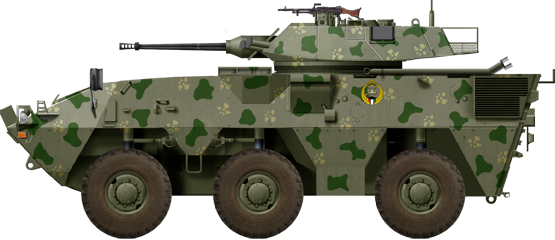
Same, IFV variant
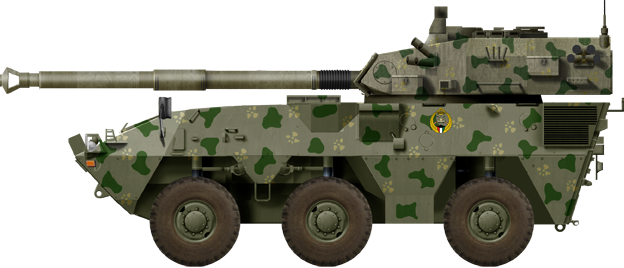
Same, ARFSV
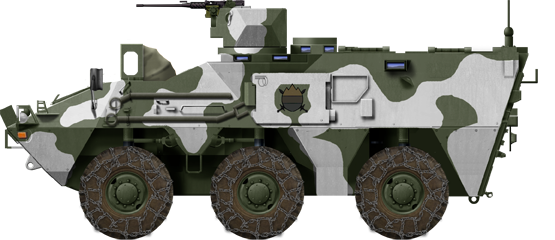
Valuk in winter manoeuvers
Video
Gallery
Austrian Pandur 1a in manoeuvers
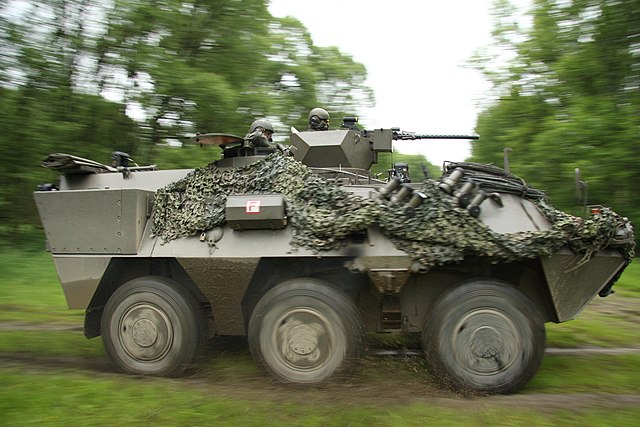
Same, with camouflage, belonging to F platoon.
Belgian Pandur in parade, Chazal avenue, Brussels, not the heavy camouflage.
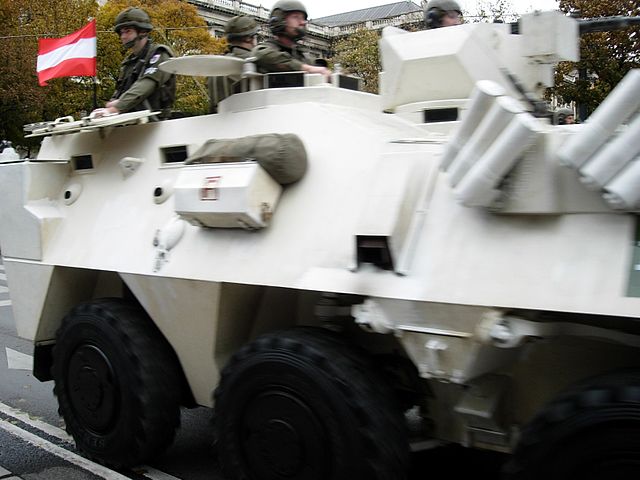
Vehicles in UN colors in a parade, Vienna October 26, 2005
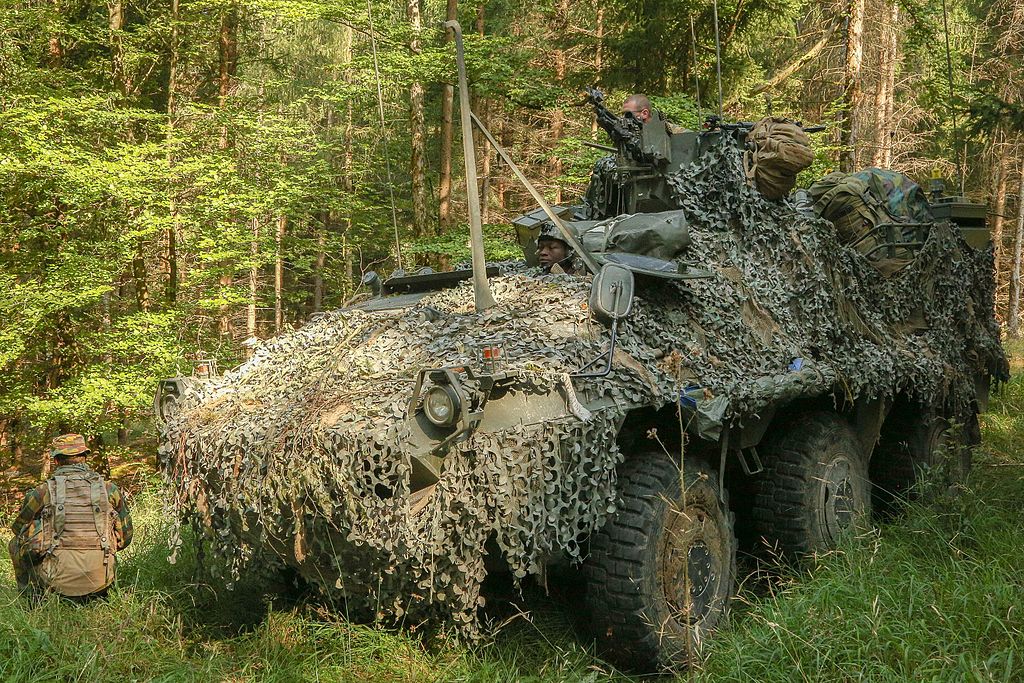
Camouflaged Belgian Pandur in Combined Resolve VII exercize
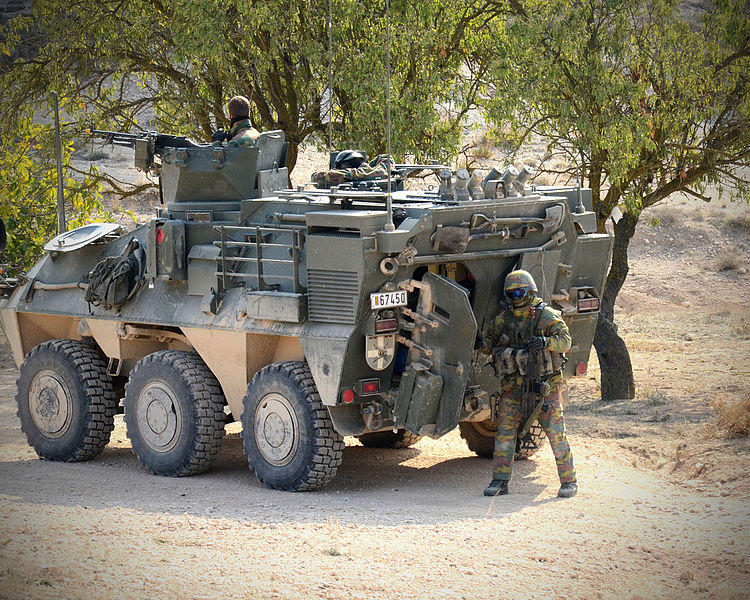
Belgian Pandur in Afghanistan
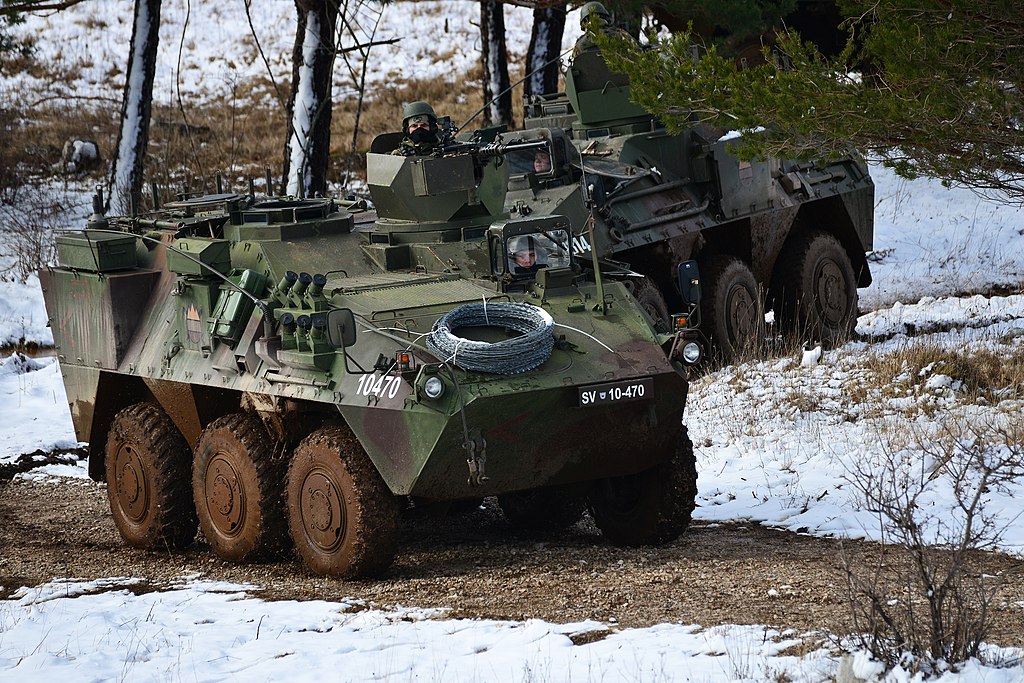
Slovenian Valuk
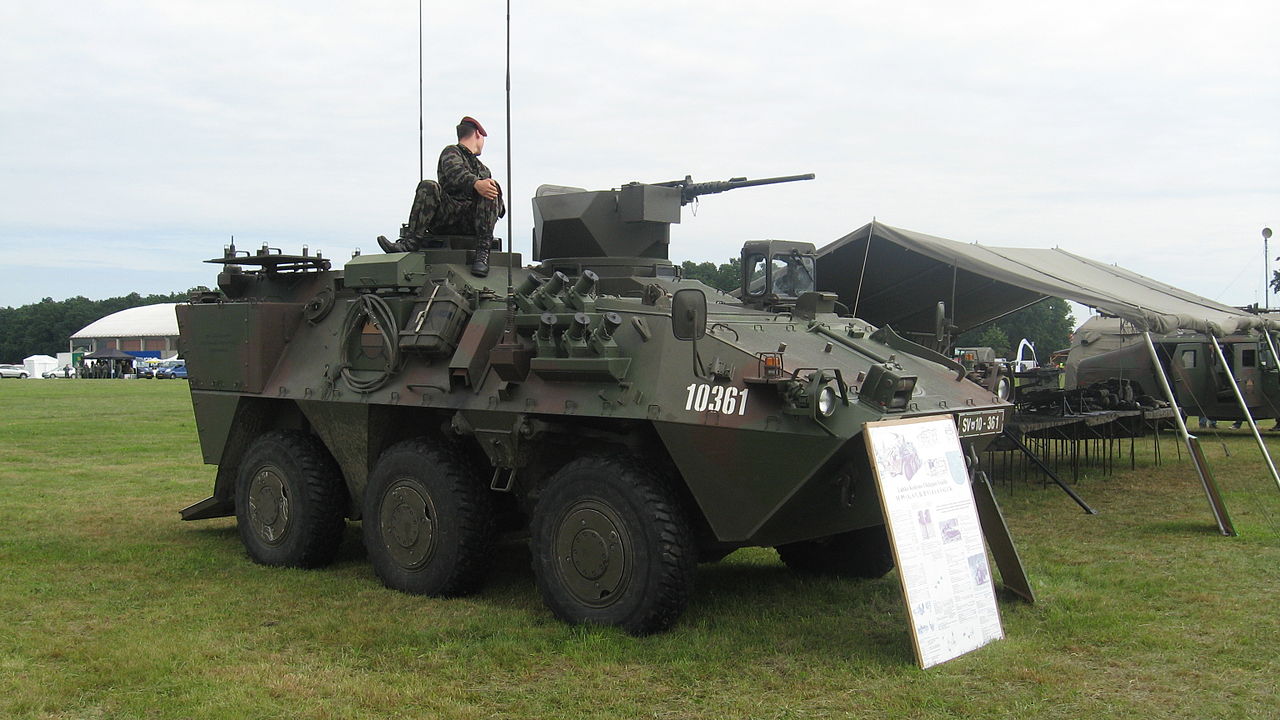
Slovenian Valuk at LKOV in 2008
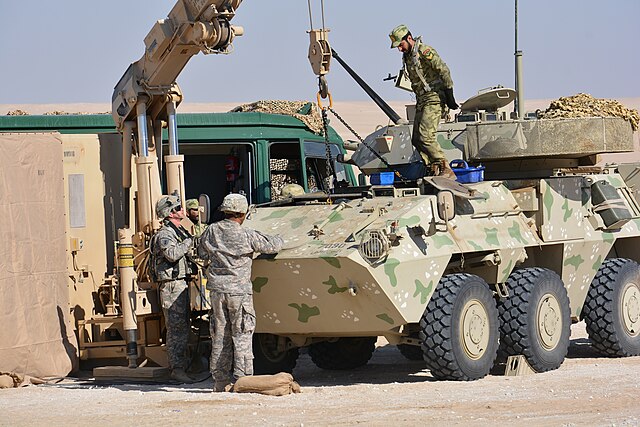
Pandur IFV in maintenance, Kuwait nat. Guard 2015
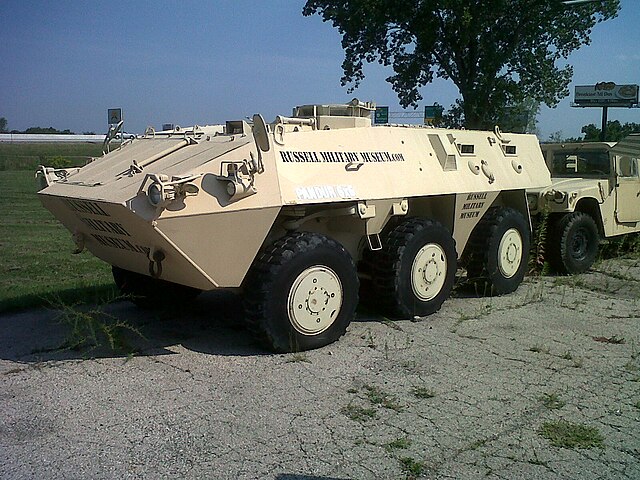
Type B hull, preserved at Russel Military Museum, Zion, Illinois.
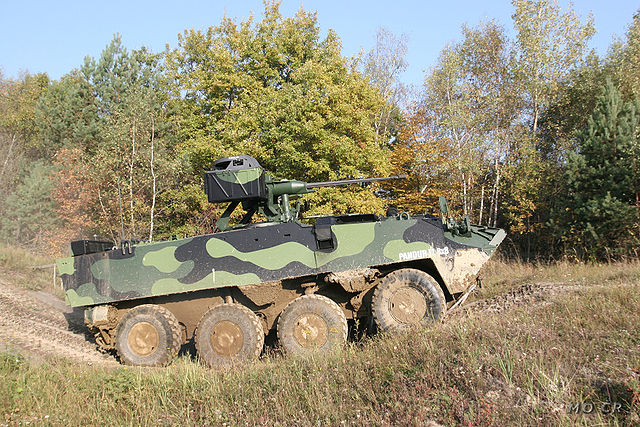
Pandur II

Cold War Tanks


































Cold war tanks posters

Cold War Main Battle Tanks

Cold War Soviet Army
Museums, Movies, Books & Games
The Tanks and Armor in pop culture
Tanks and armored vehicles in general are only really grasped when seen first person: The mass, the scale, it's all there. Explore also the way tanks were covered in the movie industry, in books and in video games.Movies:
Best tanks movie on warhistoryonline.com
On imdb.com
On bestsimilar.com/
miltours.com
liveabout.com/
watchmojo.com
Video Games:
pcgamesn.com
historyhit.com
levvvel.com
vg247.com/best-tank-games
mmobomb.com/
alienwarearena.com

